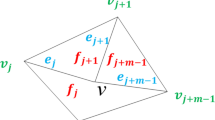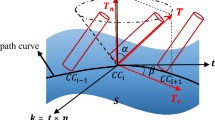Abstract
Based on the mathematical model describing the third-order approximation of the cutter envelope surface according to one given cutter location (CL), a tool positioning strategy is proposed for efficiently machining free-form surfaces with non-ball-end cutters. The optimal CL is obtained by adjusting the inclination and tilt angles of the cutter until its envelope surface and the design surface have the third-order contact at the cutter contact (CC) point, which results in a wide machining strip. The strategy can handle the constraints of machine joint angle limits, global collision avoidance and tool path smoothness in a nature way, and can be applied to general rotary cutters and complex surfaces. Numerical examples demonstrate that the third-order point contact approach can improve the machining strip width greatly as compared with the recently reported second-order one.
Similar content being viewed by others
References
Zhu L M, Zheng G, Ding H. Formulating the swept envelope of rotary cutter undergoing general spatial motion for multi-axis NC machining. Int J Mach Tool Manu, 2009, 49(2): 199–202
Zhu L M, Zhang X M, Zheng G, et al. Analytical expression of the swept surface of a rotary cutter using the envelope theory of sphere congruence. J Manuf Sci E-T ASME, 2009, 131(4): 041017-1–041017-7
Deng Z, Leu M C, Wang L, et al. Determination of flat-end cutter orientation in 5-axis machining. ASME Med, 1996, 4: 73–80
Kruth J P, Klewais P. Optimization and dynamic adaptation of the cutter inclination during five-axis milling of sculptured surfaces. CIRP Ann-Manuf Tech, 1994, 43(1): 443–448
Rao N, Bedi S, Buchal R. Implementation of the principal-axis method for machining of complex surfaces. Int J Adv Manuf Tech, 1996, 11(4): 249–257
Bedi S, Gravelle S, Chen Y H. Principal curvature alignment technique for machining complex surface. J Manuf Sci E-T ASME, 1997, 119(4B): 756–765
Warkentin A, Ismail F, Bedi S. Multi-point tool positioning strategy for 5-axis machining of sculptured surfaces. Comput Aided Geom D, 2000, 17(1): 83–100
Chiou C J, Lee Y S. A machining potential field approach to tool path generation for multi-axis sculptured surface machining. Comput Aided Design, 2002, 34(5): 357–371
Ni Y R, Ma D Z, Zhang H, et al. Optimal orientation control for torus tool 5-axis sculptured surface NC machining (in Chinese). Chinese J Mech Eng, 2001, 37(2): 87–90
Cao L X, Wu H J, Liu J. Geometrical theory of machining free form surface by cylindrical cutter in 5-axis NC machine tools (in Chinese). Chinese J Mech Eng, 2003, 39(7): 134–137
Wang X C, Wu X T, Li Y B. Curvature catering—A new concept for machining sculptured surfaces (in Chinese). J Xi’an Jiaotong Univ, 1992, 26(5): 51–58
Rao A, Sarma R. On local gouging in five-axis sculptured surface machining using flat-end tools. Comput Aided Design, 2000, 32(7): 409–420
Yoon J H, Pottmann H, Lee Y S. Locally optimal cutting positions for 5-axis sculptured surface machining. Comput Aided Design, 2003, 35(1): 69–81
Gong H, Cao L X, Liu J. Second order approximation of tool envelope surface for 5-axis machining with single point contact. Comput Aided Design, 2008, 40(5): 604–615
Zhu L M, Ding H, Xiong Y L. Third-order point contact approach for five-axis sculptured surface machining using non-ball-end tools (I): Third-order approximation of tool envelope surface. Sci China Tech Sci, 2010, 53: 1904–1912
Bi Q Z, Wang Y H, Zhu L M, et al. Generating collision-free tool orientations for 5-axis NC machining with a short ball-end cutter. Int J Prod Res, 2010, 10.1080/00207540903436679
Author information
Authors and Affiliations
Corresponding author
Rights and permissions
About this article
Cite this article
Zhu, L., Ding, H. & Xiong, Y. Third-order point contact approach for five-axis sculptured surface machining using non-ball-end tools (II): Tool positioning strategy. Sci. China Technol. Sci. 53, 2190–2197 (2010). https://doi.org/10.1007/s11431-010-3184-4
Received:
Accepted:
Published:
Issue Date:
DOI: https://doi.org/10.1007/s11431-010-3184-4




